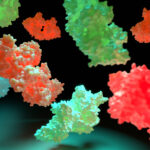
Neuroblastoma cell line labeled with fluorescent molecules. Image was taken with a digital camera on a confocal microscope. [Vshivkova/Getty Images]
Neuroblastoma, a pediatric cancer of the nervous system, remains the leading cause of cancer-related death in young children, particularly when the disease has spread. Despite aggressive treatment regimens that include surgery, radiation, chemotherapy, and immunotherapy, metastatic neuroblastoma often proves incurable, largely because the cancer can evade or resist standard therapies.
One approach, known as differentiation therapy, attempts to coax immature neuroblastoma cells into developing into mature, noncancerous nerve cells. But current differentiation treatments, such as retinoic acid (RA), are only partially effective: many patients fail to respond, and nearly half of those who do eventually relapse due to resistance.
Now, researchers at Karolinska Institutet and Lund University in Sweden have identified an alternative approach—targeting the antioxidant enzymes PRDX6 and GSTP1—that may sidestep the limitations of RA. The study, “Combined targeting of PRDX6 and GSTP1 as a potential differentiation strategy for neuroblastoma treatment,” published in Proceedings of the National Academy of Sciences, shows that dual inhibition of these enzymes not only kills some neuroblastoma cells but also transforms others into healthy, active neurons.
“The children who survive often have lifelong cognitive difficulties due to the harsh treatment, so there is a great need for new forms of therapies for children with neuroblastoma,” said Marie Arsenian Henriksson, PhD, professor at the Department of Microbiology, Tumor and Cell Biology at Karolinska Institutet.
The rationale for this new strategy lies in the high oxidative stress associated with neuroblastoma’s rewired metabolism, particularly in high-risk tumors driven by amplification of the MYCN oncogene. To cope, these cells rely heavily on peroxiredoxins, antioxidant enzymes to neutralize reactive oxygen species (ROS) that would otherwise trigger cell death. High expression levels of PRDX6 support the cells’ ability to cope with oxidative stress, which promotes tumor growth and therapy resistance, according to the researchers. PRDX6 and GSTP1 are correlated with poor survival outcomes in children with neuroblastoma.
Using both genetic knockdowns and small-molecule inhibitors (MJ33 for PRDX6 and EZ for GSTP1), the team showed that blocking these enzymes in neuroblastoma cell lines and mouse models decreased MYCN expression, induced apoptosis, and activated neuronal differentiation pathways distinct from those triggered by RA. Notably, the dual treatment increased lipid droplet accumulation—a potential step in supporting membrane synthesis during neurite outgrowth—and triggered spontaneous neuronal firing, a hallmark of functional maturation.
What sets this approach apart from conventional RA therapy is not just efficacy but the distinct molecular mechanism. Proteomic and pathway analyses revealed minimal overlap between the proteins induced by PRDX6/GSTP1 inhibition and RA, suggesting they operate through independent molecular circuits. While RA-induced differentiation is CREB- and ERK-dependent, enzyme inhibition also activated PRAS40 and ribosomal S6 kinases, hinting at a broader reprogramming effort.
In mouse xenograft models, daily injections of the dual inhibitors significantly reduced tumor burden, suppressed proliferation markers, and promoted expression of neural proteins SCG2 and tubulin B3. One of the inhibitors used, EZ (ezatiostat hydrochloride), already holds orphan drug designation from the U.S. FDA for myelodysplastic syndrome, potentially accelerating its path to pediatric trials as a promising repurposing candidate.
With its ability to induce terminal differentiation and impair tumor growth, this enzyme-targeting approach may represent a viable path forward for high-risk neuroblastoma, particularly in patients for whom RA fails. As the field pushes toward safer, more durable treatment options, PRDX6 and GSTP1 have emerged as promising molecular levers to shift the fate of cancer cells from malignancy to maturity.



